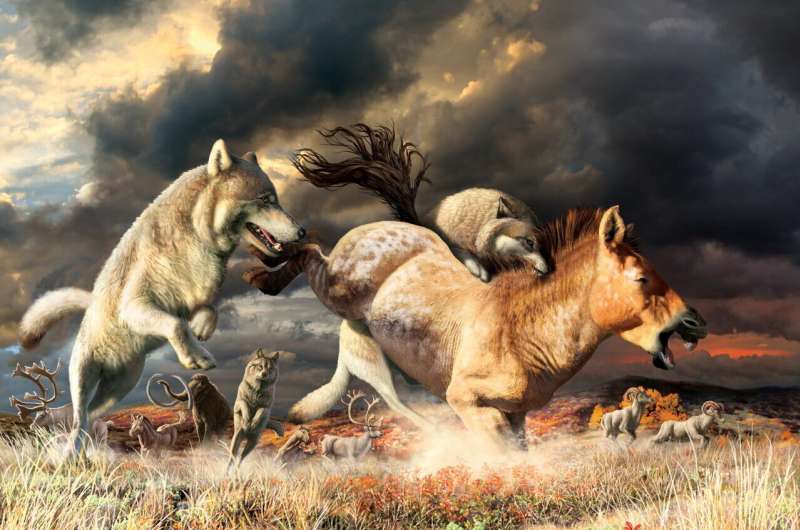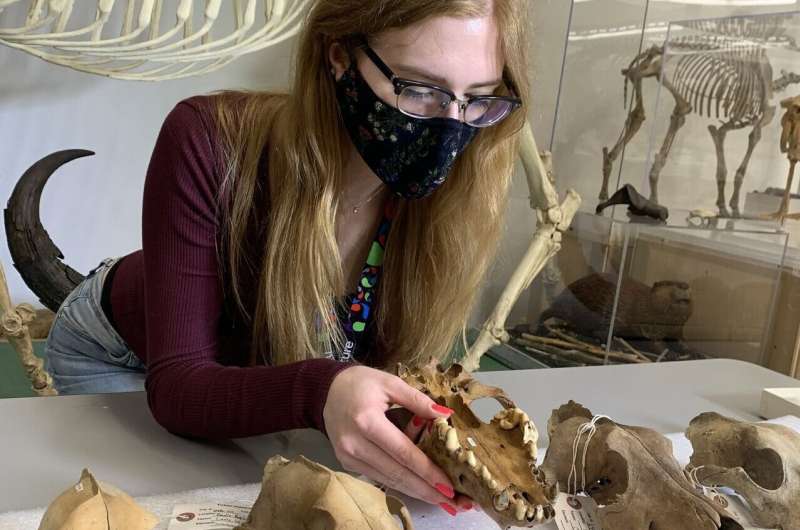
This is at least interesting as the Ice Age wolves lost their primary food source in terms of horses. Could they have hunted out the horses and been the cause of their extinction? I am inclined to think so.
The horses were not large then and likely came close to a cariboo. The moose are heavier than either and a tougher kill. In this three way race, the horse was also unlikely to wander out on the tundra away from forest cover.
The abrupt loss of the Ice Age caused a huge collapse in a number of animals adapted to those conditions. One reason that I do think that this collapse is unique. The Pleistocene menagerie represents all five million years of evolution through the ice Age. It did not happen several times..
Shift in diet allowed gray wolves to survive ice-age extinction
by Canadian Museum of Nature
Gray wolves take down a horse on the mammoth-steppe habitat of Beringia during the late Pleistocene (around 25,000 years ago). Credit: Julius Csotonyi
https://phys.org/news/2021-04-shift-diet-gray-wolves-survive.html
Gray wolves are among the largest predators to have survived the extinction at the end of the last ice age around11,700 years ago. Today, they can be found roaming Yukon's boreal forest and tundra, with caribou and moose as their main sources of food.
A new study led by the Canadian Museum of Nature shows that wolves may have survived by adapting their diet over thousands of years—-from a primary reliance on horses during the Pleistocene, to caribou and moose today. The results are published in the journal Palaeogeography, Palaeoclimatology, Palaeoecology.
The research team, led by museum palaeontologist Dr. Danielle Fraser and student Zoe Landry, analysed evidence preserved in teeth and bones from skulls of both ancient (50,000 to 26,000 years ago) and modern gray wolves. All the specimens were collected in Yukon, a region that once supported the Beringia mammoth-steppe ecosystem, and are curated in the museum's national collections as well as those of the Yukon government.
"We can study the change in diet by examining wear patterns on the teeth and chemical traces in the wolf bones," says Landry, the lead author who completed the work as a Carleton University student under Fraser's supervision. "These can tell us a lot about how the animal ate, and what the animal was eating throughout its life, up until about a few weeks before it died."
Closeup of a 40,000-year-old gray wolf skull. It was among the specimens analysed for the research project that determined the shift in diet over time of gray wolves. Credit: Danielle Fraser, © Canadian Museum of Nature.
Landry and Fraser relied on established models that can determine an animal's eating behaviour by examining microscopic wear patterns on its teeth. Scratch marks indicate the wolf would have been consuming flesh, while the presence of pits would suggest chewing and gnawing on bones, likely as a scavenger.
Analysis showed that scratch marks prevailed in both the ancient and modern wolf teeth, meaning that the wolves continued to survive as primary predators, hunting their prey.
What then were the gray wolves eating? The modern diet—caribou and moose—is well established. The diet of the ancient wolves was assessed by looking at the ratios of carbon and nitrogen isotopes extracted from collagen in the bones. Relative levels of the isotopes can be compared with established indicators for specific species. "The axiom, you are what you eat comes into play here," says Landry.
Results showed that horses, which went extinct during the Pleistocene, accounted for about half of the gray wolf diet. About 15% came from caribou and Dall's sheep, with some mammoth mixed in. All this at a time when the ancient wolves would have co-existed with other large predators such as scimitar cats and short-faced bears. The eventual extinction of these predators could have created more opportunity for the wolves to transition to new prey species.

Zoe Landry, lead author of the study, holds a 40,000-year-old gray wolf skull from the Yukon. It was among the specimens analysed for the research project that determined the shift in diet over time of gray wolves. Credit: Danielle Fraser, © Canadian Museum of Nature.
"This is really a story of ice age survival and adaptation, and the building up of a species towards the modern form in terms of ecological adaptation," notes Dr. Grant Zazula, study co-author, and Government of Yukon paleontologist who is an expert on the ice-age animals that populated Beringia.
The findings have implications for conservation today. "The gray wolves showed flexibility in adapting to a changing climate and a shift in habitat from a steppe ecosystem to boreal forest," explains Fraser. "And their survival is closely linked to the survival of prey species that they are able to eat."
Given the reliance of modern gray wolves on caribou, the study's authors suggest that the preservation of caribou populations will be an important factor in maintaining a healthy wolf population.
No comments:
Post a Comment